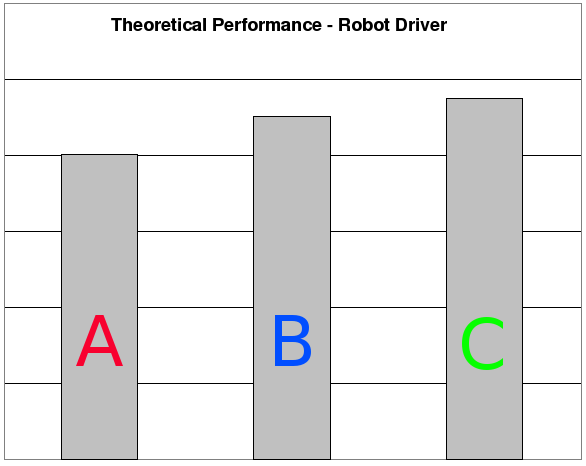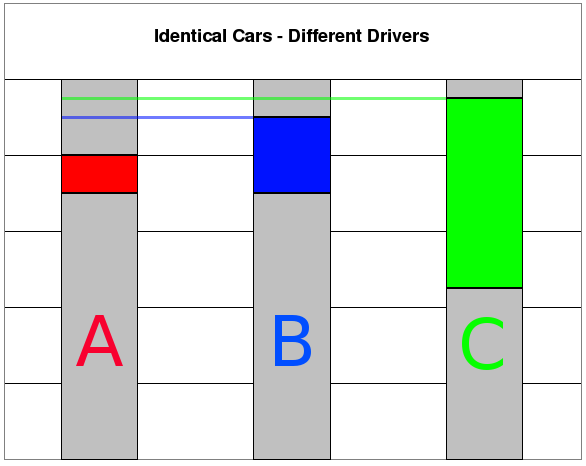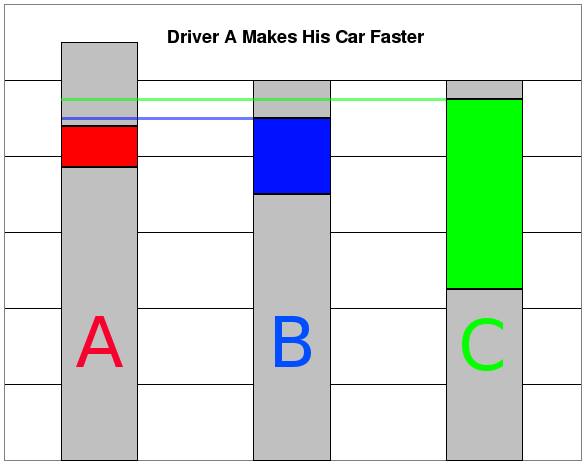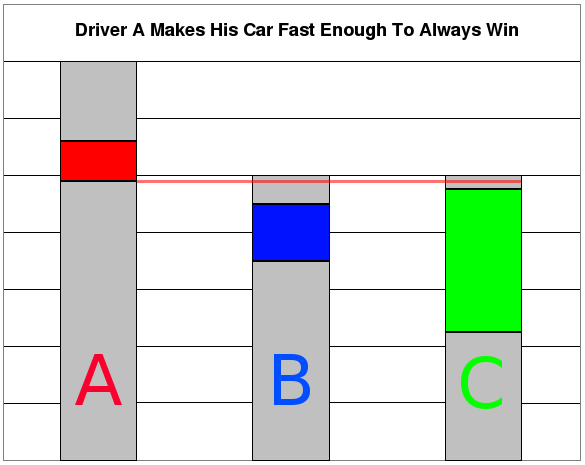The Value of the Driver
Imagine the following: you invent a robot that can drive any car on any course on any surface and on any conditions, absolutely perfectly. As such, you can put this robot in any car, send it out on course, and the resulting time will be the quickest possible for that car/course/conditions.
Do this for three cars, and you might get a graph like this (taller is better):

From this graph, we see that Car A is faster than Car B which is faster than car C - when driven by our perfect robot.
But cars aren't driven by robots, they are driven by people. People are never perfect - occasionally they may approach perfection - but there is always some variability in their performance. We can represent this as a percentage value, where a given driver on a given performance achieves a given percentage of the maximum possible performance of that car.
Remember: NO driver can do better than perfection; no matter how good of a driver you might be, your best possible outcome is to match the performance of our "perfect" hypothetical robot.
Now no driver ever drives exactly the same way every single run, and some drivers are better at approaching perfection than others. We can express the quality of a driver as two numbers: a minimum performance number, and a maximum performance number, both as percentages of maximum theoretical performance.
(Strictly speaking, we need a third parameter, a function that expresses the probability of a given performance level in that range. But I'm trying to keep this simple)
Let's look at an example:
Consider Driver A. Driver A is very consistent, but he is consistent at underdriving the car. His minimum performance is 70%, and his maximum performance is 80%
Driver B is much less consistent, but sometimes he does very well. His minimum is 70%, and his maximum is 90%.
Driver C is a loose cannon, "spin or win". His minimum is 45% and his maximum is 95%.
If we put all three drivers in the exact same car on the exact same tires, we get a graph that looks like this:

The colored areas on the graph indicate the possible performances each of the three drivers can produce. We can't predict exactly where in the range a given performance on a given day will fall, but we can predict that it will be somewhere in the colored range.
If we compare the potential performances by examining the graphs, we see that any one of our three drivers can win, as their performance bars overlap. The determining variable is where in his performance range each driver executes during the event.
Now let's say that Driver A spends some money improving the maximum performance potential of the car, improving it by 10%. Now we have a graph that looks like this:

Driver A's performance bar has moved higher relative to the other drivers. All else being equal, his chances of winning have improved. But even so, if either of his competitors execute near their maximum potential, there is still a window where he will get beaten even if he executes near or at his maximum potential.
So how much faster does Driver A have to make his car so that he can expect to always beat Drivers B and C?

Would you believe forty percent faster?
So you can see that the driver's influence on ultimate performance is by far the single greatest determinant of actual time, and that it can take a pretty big increase in potential car performance in order to offset driver performance.
Now admittedly these are are artificial numbers and I've chosen a pretty extreme example. For one thing, the performance range amongst reasonably experienced drivers is probably much narrower and nearer the top of the "theoretical maximum" bar - that will reduce the amount of theoretical maximum improvement (by modifying the car) required to ensure victory even if the driver executes a performance near the bottom of his performance range to a much saner number than forty percent. But the key concepts here are entirely valid:
- The car has a maximum theoretical performance maximum determined by its physical attributes;
- On each run, the driver will execute a performance that reaches a certain percentage of this theoretical maximum;
- A better driver will execute a higher percentage, more often, than a weaker driver; and
- It take a whole lot of car to make up for a weak driver - some drivers cannot be made competitive through a faster car.
There is a research paper waiting to be written analyzing the delta times between different cars in the same class, and particularly different drivers in the same car, at high-level events like Tours and Pros, to get a feel for the actual scale of variability driver to driver and car to car. Working this out with your team car and drivers can also be instructive.
So what?
In practical terms, if you are getting beat, the first place to go looking for problems is in the driver; as it is the driver who has the most effect on the car's performance.
The easiest place to see this is on the Licence Tests on console driving games like Grand Turismo 3. These licence tests require the driver to execute a specific task - usually complete a corner or sequence of corners - within a certain time. There is a minimum "pass" (Bronze) time, and there are Silver and Gold awards granted for completing the test in faster times. The difference between a Bronze and Gold can be several seconds, and depending on the specific test, the difference between Silver and Gold varies between a couple of seconds to a couple of tenths.
Because the car is a computer simulation, the environment and initial conditions are always the same; the only variable is the driver performance. On even very simple corners, variations in line, entry and exit speed, braking and throttle application points, and so on can produce differences in times on the orders of a full second. When you consider the average number of corners on a typical course, it is not at all difficult to imagine a couple of tenths worth of driver variability adding up to a second or two.
Seriously, if you've never tried this, pick up a PS2 or PS3 and a Grand Turismo game and try the licence tests yourself; you'll be amazed at the time variability - and also by how quickly times start dropping and start converging on your maximum with practice.
The big problem is that most red blooded males think that they spring from the womb the reincarnation of Ayrton Senna (not to mention Casanova and Sgt. York) but that simply isn't true; driving in competition is a learned skill and not one that comes naturally to anybody. It must be practiced, practiced, practiced until it is mastered, and until it is mastered, there is very little that car tuning can do for you. There are no shortages of expensive, slow cars out there. No matter how much money and time you spend tweaking the car (and some have spent hundreds of thousands of dollars) money cannot overcome skill and physics.
Most of the times that I go beat, I got beat because I was outdriven, not outengineered. And most of the times I was outdriven; I put in a shitty performance where my opponent put in a good one. I beat myself much more often than I got beat despite my best efforts.
This is, bar none, the single toughest lesson for a driver to learn. Many never learn it. They are easy to recognise; these are the guys who are quickest to cry 'foul!" whenever they think somebody else has a technical advantage over them.
The very first and most important step along the road to becoming truly fast is to get over your own ego, realize that almost everybody out there has more seat time than you, and that until you get that seat time, they will be faster.
How do you get to Carnegie Hall? Practice.
Now there is a vital difference between "just practice" and effective practice. It's not enough to just do something, you have to do it well - or at least identify deficiencies, and then rectify them. There are a couple of techniques for doing this:
- Put a data logging system in the car, and use it religiously. The logger doesn't lie; analysing each and every run can shed light on what you did (and didn't do) as a driver that did (or did not) work;
- Go to a driving school. While the schools are not the be-all, end-all of driving techniques, there is a lot of good stuff there to learn, and having a neutral set of eyeballs on your performance can reveal stuff you would otherwise miss. For even more benefit, attend a school in an instrumented car;
- My own personal routine was to, after every run, visualize it from start to finish, and identify one thing I did to not do again (with an alternate course of action) and one thing I did well (to do again). I found this eliminated one mistake a run, and built on success. It also made improving run-to-run more mentally manageable. It was easier to get a grip on improving this way, rather than just thinking 'MUST GO FASTER!!!' and flailing around; and
- Purchase a good console gaming system (PS2/PS3) and a force-feedback wheel, and drive as many racing simulation games (not the "stunt racer" games; the games that aim for simulation-quality physics) as you can. This isn't a perfect solution, as the game cannot simulate g-forces nor non-visual sensory inputs. The view is also locked forward which can interfere with looking far enough ahead on tight corners. But it is cheap seat time with little to no operating costs, and it provides immediate feedback in terms of lap times. I would also attempt to simulate race conditions by playing "time attack" mode and only allowing myself four times laps before switching tracks or switching games. It absolutely does not replace real-world seat time, but it does a very good job of augmenting seat time.
So then, why bother spending the money at all? If it's all driver, why waste any effort on the car?
Once the driving skill has been raised to a certain level, once you and your competitors are capable of putting in high-percentile performances, then the small differences between cars start to become significant. At the National level, performances amongst the top drivers are high enough such that the variation in potential between different tire constructions is of a similar order to differences between driver performances. Differences between other aspects of the car tend to be of a far smaller order than tires, but get enough small things right and they start to add up. Once you get good enough as a driver, you can get beat because you were on the wrong tires, or because your setup was suboptimal.
To put this in perspective, of the number of times I got beat, I figure 75% of them were due to me not driving at my full potential, 20% of them due to being on the wrong tire, and the remaining 5% due to being on the wrong shocks/springs/bars. Of the people I beat (not counting blatant backmarkers) I think I only out-car-ed everybody (where there was no chance of me losing if I put in a decent performance) maybe once or twice - certainly no more than five times.
That ratio - 75% driver, 20% tire, 5% setup - is not hard science, but it feels about right, for cars similarity classed.
I also found that properly-tuned setups got easier to drive. And if the car is easier to drive, then it is easier to perform at the upper end of your range, more often.
Bottom line here: learn to drive before you start spending money and turning wrenches; it's the best investment you can make.

 Caveat Lector!
Caveat Lector!

